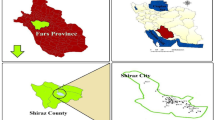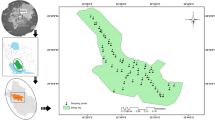Abstract
The heavy metals available in drinking water can be considered as a threat to human health. Oncogenic risk of such metals is proven in several studies. Present study aimed to investigate concentration of the heavy metals including As, Cd, Cr, Cu, Fe, Hg, Mn, Ni, Pb, and Zn in 39 water supply wells and 5 water reservoirs within the cities Ardakan, Meibod, Abarkouh, Bafgh, and Bahabad. The spatial distribution of the concentration was carried out by the software ArcGIS. Such simulations as non-carcinogenic hazard and lifetime cancer risk were conducted for lead and nickel using Monte Carlo technique. The sensitivity analysis was carried out to find the most important and effective parameters on risk assessment. The results indicated that concentration of all metals in 39 wells (except iron in 3 cases) reached the levels mentioned in EPA, World Health Organization, and Pollution Control Department standards. Based on the spatial distribution results at all studied regions, the highest concentrations of metals were derived, respectively, for iron and zinc. Calculated HQ values for non-carcinogenic hazard indicated a reasonable risk. Average lifetime cancer risks for the lead in Ardakan and nickel in Meibod and Bahabad were shown to be 1.09 × 10−3, 1.67 × 10−1, and 2 × 10−1, respectively, demonstrating high carcinogenic risk compared to similar standards and studies. The sensitivity analysis suggests high impact of concentration and BW in carcinogenic risk.










Similar content being viewed by others
References
Adepoju-Bello A, Alabi O (2005) Heavy metals: a review. The Nig. J. Pharm 37:41–45
Adepoju-Bello A, Ojomolade O, Ayoola G, Coker H (2009) Quantitative analysis of some toxic metals in domestic water obtained from Lagos metropolis. Nig J Pharm 42:57–60
Alves RI, Sampaio CF, Nadal M, Schuhmacher M, Domingo JL, Segura-Muñoz SI (2014) Metal concentrations in surface water and sediments from Pardo River, Brazil: human health risks. Environ Res 133:149–155
Arnous MO, Aboulela HA, Green DR (2011) Geo-environmental hazards assessment of the north western Gulf of Suez, Egypt. J Coast Conserv 15:37–50
Babel S, Kurniawan TA (2003) Low-cost adsorbents for heavy metals uptake from contaminated water: a review. J Hazard Mater 97:219–243
Barakat M (2011) New trends in removing heavy metals from industrial wastewater. Arab J Chem 4:361–377
Briggs DJ, Collins S, Elliott P, Fischer P, Kingham S, Lebret E, Pryl K, Van Reeuwijk H, Smallbone K, Van der Veen A (1997) Mapping urban air pollution using GIS: a regression-based approach. Int J Geogr Inf Sci 11:699–718
Cattle JA, Mcbratney A, Minasny B (2002) Kriging method evaluation for assessing the spatial distribution of urban soil lead contamination. J Environ Qual 31:1576–1588
Chanpiwat P, Lee B-T, Kim K-W, Sthiannopkao S (2014) Human health risk assessment for ingestion exposure to groundwater contaminated by naturally occurring mixtures of toxic heavy metals in the Lao PDR. Environ Monit Assess 186:4905–4923
Cocârţă D, Neamţu S, Deac AR (2016) Carcinogenic risk evaluation for human health risk assessment from soils contaminated with heavy metals. Int J Environ Sci Technol 13:2025–2036
Dan JG, Guix A, Martí V, Arnaldos J, Darbra R (2016) Monte Carlo simulation as a tool to show the influence of the human factor into the quantitative risk assessment. Process Saf Environ Prot 102:441–449
Demir V, Dere T, Ergin S, Cakir Y, Celik F (2015) Determination and health risk assessment of heavy metals in drinking water of Tunceli, Turkey. Water resources 42:508–516
Fallahzadeh RA, Almodaresi SA, Dashti MM, Fattahi A, Sadeghnia M, Eslami H, Khosravi R, Minaee RP, Taghavi M (2016) Zoning of nitrite and nitrate concentration in groundwater using geographic information system (GIS), case study: drinking water wells in Yazd City. J Geosci Environ Prot 4:91
Federation, W. E. & Association, A (2005) Standard methods for the examination of water and wastewater. American Public Health Association (APHA), Washington
Fedra, K. 1994. GIS and environmental modeling, International Institute for Applied Systems Analysis
Ferre-Huguet N, Nadal M, Schuhmacher M, Domingo JL (2009) Human health risk assessment for environmental exposure to metals in the Catalan stretch of the Ebro River, Spain. Hum Ecol Risk Assess 15:604–623
Geng M, Qi H, Liu X, Gao B, Yang Z, Lu W, Sun R (2016) Occurrence and health risk assessment of selected metals in drinking water from two typical remote areas in China. Environ Sci Pollut Res 23:8462–8469
Ghodeif KO, Arnous MO, Geriesh MH (2013) Define a protected buffer zone for Ismailia Canal, Egypt using geographic information systems. Arab J Geosci 6:43–53
Greenland S (2001) Sensitivity analysis, Monte Carlo risk analysis, and Bayesian uncertainty assessment. Risk Anal 21:579–584
Javed M, Usmani N (2016) Accumulation of heavy metals and human health risk assessment via the consumption of freshwater fish Mastacembelus armatus inhabiting, thermal power plant effluent loaded canal. SpringerPlus 5:776
Karbassi, A., Nouri, J. & Ayaz, G. 2007. Flocculation of Cu, Zn, Pb, Ni and Mn during mixing of Talar river water with Caspian seawater
Kavcar P, Sofuoglu A, Sofuoglu SC (2009) A health risk assessment for exposure to trace metals via drinking water ingestion pathway. Int J Hyg Environ Health 212:216–227
Khosravi R, Eslami H, Almodaresi SA, Heidari M, Fallahzadeh RA, Taghavi M, Khodadadi M, Peirovi R (2017) Use of geographic information system and water quality index to assess groundwater quality for drinking purpose in Birjand City, Iran. Desalin Water Treat 67:74–83
Koki IB, Bayero AS, Umar A, Yusuf S (2015) Health risk assessment of heavy metals in water, air, soil and fish. Afr J Pure Appl Chem 9:204–210
Lei L, Liang D, Yu D, Chen Y, Song W, Li J (2015) Human health risk assessment of heavy metals in the irrigated area of Jinghui, Shaanxi, China, in terms of wheat flour consumption. Environ Monit Assess 187:647
Liang F, Yang S, Sun C (2011) Primary health risk analysis of metals in surface water of Taihu Lake, China. Bull Environ Contam Toxicol 87:404
Liu C-W, Jang C-S, Liao C-M (2004) Evaluation of arsenic contamination potential using indicator kriging in the Yun-Lin aquifer (Taiwan). Sci Total Environ 321:173–188
Lu S-Y, Zhang H-M, Sojinu SO, Liu G-H, Zhang J-Q, Ni H-G (2015) Trace elements contamination and human health risk assessment in drinking water from Shenzhen, China. Environ Monit Assess 187:4220
Ma L, Ascough J, Ahuja L, Shaffer M, Hanson J, Rojas K (2000) Root zone water quality model sensitivity analysis using Monte Carlo simulation. Trans ASAE 43:883–896
Maghakyan, N., Tepanosyan, G., Belyaeva, O., Sahakyan, L. & Saghatelyan, A. (2017) Assessment of pollution levels and human health risk of heavy metals in dust deposited on Yerevan’s tree leaves (Armenia). Acta Geochimica 36(1):16–26. https://link.springer.com/article/10.1007/s11631-016-0122-6
Marcovecchio JE, Botté SE, Freije RH (2007) Heavy metals, major metals, trace elements. Handbook of Water Analysis 2:275–311
Merchant JW (1994) GIS-based groundwater pollution hazard assessment: a critical review of the DRASTIC model. Photogramm Eng Remote Sens 60:1117–1128
Mimi ZA, Assi A (2009) Intrinsic vulnerability, hazard and risk mapping for karst aquifers: a case study. J Hydrol 364:298–310
Miri M, Shendi MRA, Ghaffari HR, Aval HE, Ahmadi E, Taban E, Gholizadeh A, Aval MY, Mohammadi A, Azari A (2016) Investigation of outdoor BTEX: concentration, variations, sources, spatial distribution, and risk assessment. Chemosphere 163:601–609
Nawab J, Khan S, Ali S, Sher H, Rahman Z, Khan K, Tang J, Ahmad A (2016) Health risk assessment of heavy metals and bacterial contamination in drinking water sources: a case study of Malakand agency, Pakistan. Environ Monit Assess 188:1–12
PCD 2000. Ground water quality standards for drinking purposes, http://www.pcd.go.th/info_serv/en_reg_std_water01.html#s1 . [Online]. Ministry of Natural Resources and Environment
Ren L, He L, Lu H, Chen Y (2016) Monte Carlo-based interval transformation analysis for multi-criteria decision analysis of groundwater management strategies under uncertain naphthalene concentrations and health risks. J Hydrol 539:468–477
Şener, Ş., Şener, E. & Davraz, A. 2016. Assessment of groundwater quality and health risk in drinking water basin using GIS. J Water Health, wh2016148
Tiwari AK, Singh PK, Singh AK, De Maio M (2016) Estimation of heavy metal contamination in groundwater and development of a heavy metal pollution index by using GIS technique. Bull Environ Contam Toxicol 96:508–515
Turdi M, Yang L (2016) Trace elements contamination and human health risk assessment in drinking water from the agricultural and pastoral areas of Bay County, Xinjiang, China. Int J Environ Res Public Health 13:938
USEPA (2005) Guidelines for carcinogen risk assessment. In: EPA-603-P-03-001F. United States Environmental Protection Agency, Washington DC
USEPA 2012. Ground water and drinking water, https://www.Epa.Gov/Ground-water-and-drinking-water/table-regulated-drinking-water-contaminants. (US Environmental Protection Agency)
Vodela J, Renden J, Lenz S, Mcelhenney W, Kemppainen B (1997) Drinking water contaminants (arsenic, cadmium, lead, benzene, and trichloroethylene). 1. Interaction of contaminants with nutritional status on general performance and immune function in broiler chickens. Poult Sci 76:1474–1492
WHO (2007) Quality assurance of pharmaceuticals: a compendium of guidelines and related materials. World Health Organization, Good manufacturing practices and inspection
WHO (2011) Guideline for drinking water quality (fourth ed.). World Health Organization (WHO), Geneva
Wiltse J, Dellarco VL (1996) US environmental protection agency guidelines for carcinogen risk assessment: past and future. Mutat Res/Rev Genet Toxicol 365:3–15
Wongsasuluk P, Chotpantarat S, Siriwong W, Robson M (2014) Heavy metal contamination and human health risk assessment in drinking water from shallow groundwater wells in an agricultural area in Ubon Ratchathani Province, Thailand. Environ Geochem Health 36:169–182
Wu B, Zhao D, Jia H, Zhang Y, Zhang X, Cheng S (2009) Preliminary risk assessment of trace metal pollution in surface water from Yangtze River in Nanjing Section, China. Bull Environ Contam Toxicol 82:405–409
Xie Y, Chen T-B, Lei M, Yang J, Guo Q-J, Song B, Zhou X-Y (2011) Spatial distribution of soil heavy metal pollution estimated by different interpolation methods: accuracy and uncertainty analysis. Chemosphere 82:468–476
Yan X, Shi W, Zhao W, Luo N (2015) Mapping dustfall distribution in urban areas using remote sensing and ground spectral data. Sci Total Environ 506:604–612
Zhao, X., Li, T.-Y., Zhang, T.-T., Luo, W.-J. & Li, J.-Y. 2016. Distribution and health risk assessment of dissolved heavy metals in the Three Gorges Reservoir, China (section in the main urban area of Chongqing). Environ Sci Pollut Res, 1–14
Author information
Authors and Affiliations
Corresponding author
Additional information
Responsible editor: Philippe Garrigues
Rights and permissions
About this article
Cite this article
Fallahzadeh, R.A., Ghaneian, M.T., Miri, M. et al. Spatial analysis and health risk assessment of heavy metals concentration in drinking water resources. Environ Sci Pollut Res 24, 24790–24802 (2017). https://doi.org/10.1007/s11356-017-0102-3
Received:
Accepted:
Published:
Issue Date:
DOI: https://doi.org/10.1007/s11356-017-0102-3




